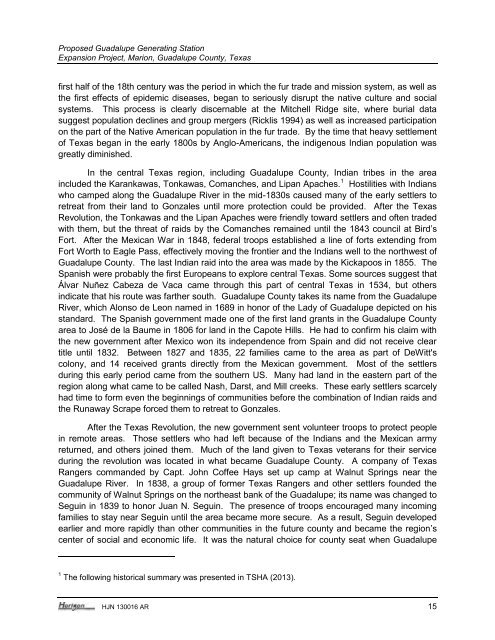Guadalupe Generating Station Final Cultural Resourse Report - US ...
Guadalupe Generating Station Final Cultural Resourse Report - US ...
Guadalupe Generating Station Final Cultural Resourse Report - US ...
You also want an ePaper? Increase the reach of your titles
YUMPU automatically turns print PDFs into web optimized ePapers that Google loves.
Proposed <strong>Guadalupe</strong> <strong>Generating</strong> <strong>Station</strong><br />
Expansion Project, Marion, <strong>Guadalupe</strong> County, Texas<br />
first half of the 18th century was the period in which the fur trade and mission system, as well as<br />
the first effects of epidemic diseases, began to seriously disrupt the native culture and social<br />
systems. This process is clearly discernable at the Mitchell Ridge site, where burial data<br />
suggest population declines and group mergers (Ricklis 1994) as well as increased participation<br />
on the part of the Native American population in the fur trade. By the time that heavy settlement<br />
of Texas began in the early 1800s by Anglo-Americans, the indigenous Indian population was<br />
greatly diminished.<br />
In the central Texas region, including <strong>Guadalupe</strong> County, Indian tribes in the area<br />
included the Karankawas, Tonkawas, Comanches, and Lipan Apaches. 1 Hostilities with Indians<br />
who camped along the <strong>Guadalupe</strong> River in the mid-1830s caused many of the early settlers to<br />
retreat from their land to Gonzales until more protection could be provided. After the Texas<br />
Revolution, the Tonkawas and the Lipan Apaches were friendly toward settlers and often traded<br />
with them, but the threat of raids by the Comanches remained until the 1843 council at Bird’s<br />
Fort. After the Mexican War in 1848, federal troops established a line of forts extending from<br />
Fort Worth to Eagle Pass, effectively moving the frontier and the Indians well to the northwest of<br />
<strong>Guadalupe</strong> County. The last Indian raid into the area was made by the Kickapoos in 1855. The<br />
Spanish were probably the first Europeans to explore central Texas. Some sources suggest that<br />
Álvar Nuñez Cabeza de Vaca came through this part of central Texas in 1534, but others<br />
indicate that his route was farther south. <strong>Guadalupe</strong> County takes its name from the <strong>Guadalupe</strong><br />
River, which Alonso de Leon named in 1689 in honor of the Lady of <strong>Guadalupe</strong> depicted on his<br />
standard. The Spanish government made one of the first land grants in the <strong>Guadalupe</strong> County<br />
area to José de la Baume in 1806 for land in the Capote Hills. He had to confirm his claim with<br />
the new government after Mexico won its independence from Spain and did not receive clear<br />
title until 1832. Between 1827 and 1835, 22 families came to the area as part of DeWitt's<br />
colony, and 14 received grants directly from the Mexican government. Most of the settlers<br />
during this early period came from the southern <strong>US</strong>. Many had land in the eastern part of the<br />
region along what came to be called Nash, Darst, and Mill creeks. These early settlers scarcely<br />
had time to form even the beginnings of communities before the combination of Indian raids and<br />
the Runaway Scrape forced them to retreat to Gonzales.<br />
After the Texas Revolution, the new government sent volunteer troops to protect people<br />
in remote areas. Those settlers who had left because of the Indians and the Mexican army<br />
returned, and others joined them. Much of the land given to Texas veterans for their service<br />
during the revolution was located in what became <strong>Guadalupe</strong> County. A company of Texas<br />
Rangers commanded by Capt. John Coffee Hays set up camp at Walnut Springs near the<br />
<strong>Guadalupe</strong> River. In 1838, a group of former Texas Rangers and other settlers founded the<br />
community of Walnut Springs on the northeast bank of the <strong>Guadalupe</strong>; its name was changed to<br />
Seguin in 1839 to honor Juan N. Seguin. The presence of troops encouraged many incoming<br />
families to stay near Seguin until the area became more secure. As a result, Seguin developed<br />
earlier and more rapidly than other communities in the future county and became the region’s<br />
center of social and economic life. It was the natural choice for county seat when <strong>Guadalupe</strong><br />
1 The following historical summary was presented in TSHA (2013).<br />
HJN 130016 AR 15
















